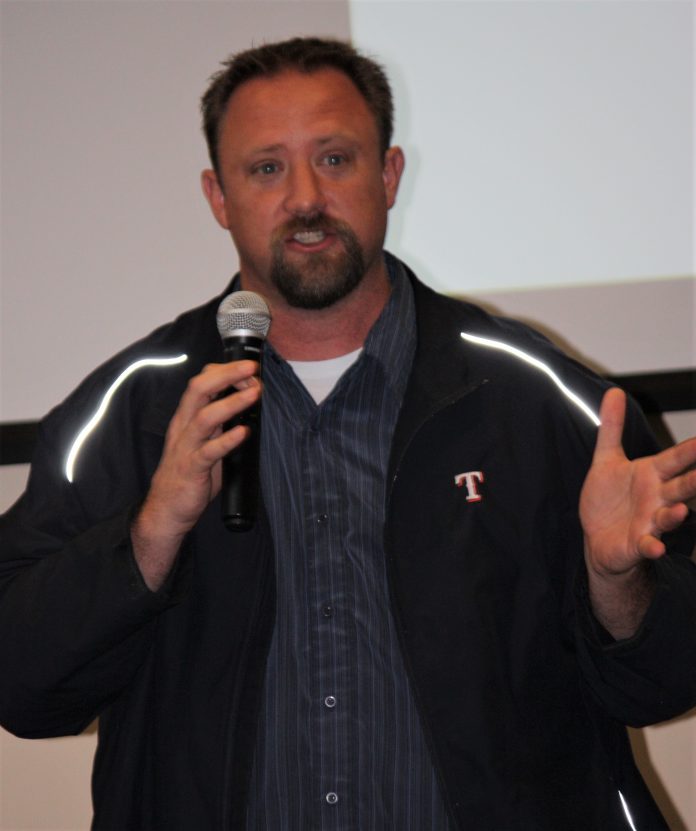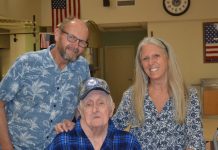By Colleen Janssen
The problem of homelessness is solvable. It takes money, time, and targeted effort. Buena Park is leading the way in the effort to help homeless people in their community. By seeing homeless people as individuals instead of a nameless group, they are getting the job done with help from City Net.
By Colleen Janssen
The problem of homelessness is solvable. It takes money, time, and targeted effort. Buena Park is leading the way in the effort to help homeless people in their community. By seeing homeless people as individuals instead of a nameless group, they are getting the job done with help from City Net.
Lieutenant Brad Geyer was the Buena Park Police Department representative at the recent community meeting, ‘Navigating the Impact of Homelessness.’ More than 100 people attended, many representing the police department, Buena Park City Council, Orange County Fire Authority, Buena Park Code Enforcement, business owners, family members of homeless individuals, community members, and formerly homeless individuals.
“The event is being filmed for future broadcast on the local cable channel and Youtube,” said spokesperson Sergeant Mike Lovchik.
“The department receives calls from citizens regarding homeless people urinating in public, loitering, etc.,” said Geyer. “We try to accommodate the person who is complaining, but there are legal limits to what we can do.”
“We realized we needed a more proactive approach and worked with City officials to create a more practical approach,” said Geyer. “We had to establish the root causes of homelessness. Our problem is not as big as Santa Ana where there are 600 people living in the riverbed.”
“People need food and shelter, so we do outreach with our partner, City Net who helps to get them into housing. So far, City Net counts 96 clients who have been exited from the streets with only two returning to homelessness. That’s a 98% success rate.
The homeless can be categorized into three areas; the Have Nots, the Will Nots, and the Can Nots. The Have Nots are people who can be assisted. They might have been laid off from a job or fired and don’t have the needed skills to get a job. They just need some support to get restarted in a job and housing.”
“The Will Nots are on drugs or alcohol. Their substance abuse makes them content to stay on the street. The challenge is to offer outreach and get them to accept assistance. If they are in violation of the law, we are obligated to deal with it, sending them to jail, issuing citations, etc.”
“Some will get tired of dealing with police and jail and change their mind. Some will finally go to rehab, although it may take repeat trips to rehab to finally get out of homelessness. Substance abuse is a big problem everywhere.”
“The Can Nots don’t have the ability due to health, mental, or physical problems. We partner with the County psychology team to have a clinician ride with the police officers and do case management. Geyer asked the audience if they knew the location of the largest mental health facility. His answer, “The Los Angeles County Jail. Many of the Can Nots don’t believe they are mentally ill and need multiple options.”
According to Geyer, the key is to never give up. Some people want the help, but it may take multiple attempts. He directed attention to photos he had of homeless camps in the city. The unsanitary mess is a challenge for police and nearby businesses and homes. Most are true health hazards due to buckets filled with excrement, used needles and more.
“Many of these people hang out in public parks which is allowed. The parks are for everyone. However, they are not allowed to stow property in a park. Many need storage places, so we work with them.”
“There are some who don’t want to be a nuisance. They just want to get by,” continued Geyer. “Some are aggressive or violent. These are a minority. Then, there are others who just don’t care.”
Geyer showed statistics indicating that the police spend up to 300 hours per month dealing with homeless issues. Summer is the busiest time.
“People think the way to help is to hand them money. This contributes to the problem. Call the police department. We can better manage the problem and help contribute to a long-term solution.”
“We get calls for help but then get asked why we are picking on them,” said Commander Rich Forsyth. “We get mixed signals from the community. Mental problems are magnified by drugs, especially methamphetamine. This is not just a law enforcement issue, but some people are naïve about the issue and interfere.”
Geyer brought up myths vs facts about homelessness. People say ‘They want to be homeless.’ “No one when they were young said, ‘I want to be a homeless alcoholic.”
Sometimes people have been in situations so long they don’t know how to get out. Geyer explained that one man has been homeless for 30 years and thinks this is his life. He is comfortable. Geyer tells him “I haven’t given up on you.”
City officials, including Mayor Beth Swift and Council Member Art Brown both shared the council’s use of Community Development Block Grant (CDBG) funds to solve homelessness in the city.
Some formerly homeless individuals shared their experiences with City Net and how grateful they are for the help they received that finally got them off the streets, back in housing.
Brad Fieldhouse from City Net answered questions about the work they do to help homeless people be successful in their transition back to housing and jobs. Through the city’s program called Bright Paths, City Net and the City of Buena Park are making a difference one person at a time.
Residents who want to help can volunteer for the upcoming census being taken in late May. More volunteers are needed. Those interested may call Fieldhouse at 562-2080-500.











